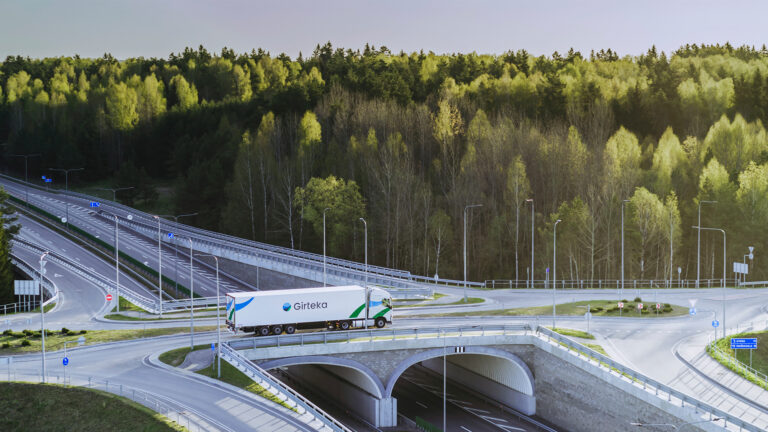Share it:
For more than a decade, Germany has been the biggest economy in the European Union (EU). However, the country’s former economic glory has faded slightly as of late. Following the 2023 recession, recovery is expected to be sluggish at best, according to current economic indicators. We take a closer look at the trends in German economy to find out what the ripple effects on road freight transportation may be.
According to data by Eurostat, the official statistics portal of the European Commission (EC), the country has led the rankings as the largest economy in Europe since the country was reunified in 1990, with its General Domestic Product (GDP) growing from €1.2 trillion in 1990 to €4.1 trillion in 2023, surpassing other EU bloc countries by a mile.
But in the past few years, the EU and, in turn, Germany, have experienced slower growth due to the war in Ukraine, resulting in a high inflation environment and higher borrowing costs. According to the EC’s economic forecast for the country, Germany’s GDP is expected to grow by only 0.1% in 2024. Although sluggish, is a slightly better situation compared to the -0.3% dip in 2023.
“Private consumption suffered from a loss in purchasing power. High building and borrowing costs on top of labour shortages and elevated energy prices depressed investment in construction and energy-intensive sectors,” the EC described the country’s economic situation in 2023.
Europe’s Manufacturing powerhouse
According to an article published by Indiana University, Germany had the third-largest manufacturing share of GDP in 2015, only trailing behind China and South Korea, with manufacturing also being a key area of employment within the country. Furthermore, 52% of the country’s GDP was generated by exports, compared to 14% in the United States (US).
As a result, Germany had managed to have a net trade surplus in 2015. The latest data from the Federal Statistical Office of Germany (Statistisches Bundesamt) showed that in 2023, the country exported goods worth €1.6 trillion while importing €1.4 trillion.
What was troubling was that the German statistical office said that exports decreased by 2% while imports dropped by 10.2%, creating an imbalance that influences the prices of transportation, including road freight transportation.
However, looking at the country’s EU-only exports and imports, both have dipped Year-on-Year (YoY) similarly. Germany’s exports to other EU countries amounted to €847.3 billion (-3.2% YoY), while imports reached €709.6 billion (-3.4% YoY).
A recovering economy?
According to the EC, while GDP should grow by 0.1% in 2024, “sentiment indicators continue to be weak, with some indicators in January having reached their lowest levels since the COVID-19 crisis, pointing to subdued economic growth in the first half of 2024.”
Moreover, “investment growth is projected to remain low relative to pre-pandemic values, weighed down by downbeat investor sentiment entering the year. Labour shortages continue to be a bottleneck to activity.”
Interestingly, the Commission said that a trade-led recovery was unlikely, as export and import growth should continue at the same pace as forecasted previously. Furthermore, tighter fiscal policy conditions should weigh down short-term growth prospects.
Is there any hope on the horizon? For one, the EC said that market financing conditions had eased moderately, with further easing expected in due time. In addition, with a robust labour market and rising real wages, consumers should have much more purchasing power than previously.
Key challenges from Germany’s economy
According to one website, coordinated by the German Federal Foreign Office (Auswärtiges Amt, AA), four sectors dominate the country’s industry: automotive manufacturing, mechanical engineering, the chemical, and electrical industry. In 2020, the turnover of companies involved in manufacturing was €2 trillion, with the automotive sector leading the way with combined revenues of €459 billion.
The question is whether Germany can continue being the global manufacturing powerhouse, considering the continuous rise of China and the US attempting to bring back some of its manufacturing back on home soil. At the same time, some companies are divesting from China and opening up facilities in other countries that do not have as much geopolitical risk.
Coming back to Germany – economic research by BNP Paribas concluded that any rebound of the country’s economy is expected to be cyclical since many factors that have caused its stagnation still persist. One of the challenges will be to make Germany’s economy more sustainable and considering the country’s reliance on energy-intensive sectors to produce goods, it could lead to some shocks to consumers.
“One of the risks for the country is that the drop in emissions goes hand in hand with a more pronounced wave of de-industrialisation (and offshoring) than the one that has already taken place, as measured by the drop in industrial production capacities between the end of 2017 and the end of 2023, which we estimate at -6%,” researchers point out.
Meanwhile, the German Federal Bank (Deutsche Bundesbank, DBB) highlights the uncertainty surrounding energy supply and costs, which will affect business investment, according to a report from December 2022. Furthermore, while order books were filled with backorders due to the shortage of goods, the country’s export-oriented market suffered due to high energy prices.
Since then, energy costs have plummeted. After peaking several times following Russia’s invasion of Ukraine in February 2022, Germany’s electricity spot prices peaked at €658.41 per megawatt hour (MWh) on August 22, 2022. They have since dropped to around €91/MWh on March 19, 2024.
Automakers’ sentiment
Still, when providing its outlook for 2024, the Volkswagen Group (VAG) was not overly optimistic about the short-term future. Some of the risks the group highlighted included intensifying competition, further supply chain disruption, and the two major conflicts, namely the Russia-Ukraine war and the war in Israel, which could lead to rising materials prices and declining energy availability.
“We predict that trends in the markets for passenger cars in the individual regions will be mixed but predominantly positive in 2024. Overall, the global volume of new car sales is expected to be slightly higher than in the previous year.” Still, VAG expects to deliver 3% more units in 2024 than in 2023, despite a challenging market environment.
Meanwhile, the Mercedes-Benz Group expected the world economy “to continue to grow at a slower pace in 2024.” The slowdown will be driven by major industrial countries that are struggling to deal with higher interest rates. Speaking about the eurozone, “the absence of monetary and fiscal policy stimuli can be expected to lead to continued economic weakness in the first half of the year at least.”
Lastly, Bosch, a large supplier of technology and services, said in its 2023 preliminary report that it expects moderate global economic growth in 2024, with Markus Forschner, a member of the board and chief financial officer (CFO) of Bosch, remarking that the global economy should pick up momentum in 2025. “The outlook in all our key sectors is gloomy,” concluded Forschner.
Dropping road freight rates
In its latest European Road Freight Market Benchmark, Transport Insight (TI), Upply, and the International Road Transport Union (IRU) released in February 2024 concluded that its forecasted downward trends have come to fruition following weak and failing demand for road transportation in Europe last year. However, contractual load rates had grown for the second consecutive quarter (Q4 2023).
Overall, the benchmark, which uses Q1 2017 as its starting point (=100), estimated that the average contracted and spot load rates were 129.4 and 123.8, respectively. “A combination of spot falls driven by declining industrial demand, in addition to contract rises caused by new emission tolls and general cost growth, resulted in contract prices climbing above spot rates from Germany to Paris, Birmingham, Milan, Lille, Madrid, Rotterdam, and Antwerp,” the report said.
Following changes to the tolling system within the EU, costs have also increased. For brief context, the EU has mandated member states to introduce CO2-based tolling, effective March 24, 2024. The new rates will have a further negative impact on the road freight sector, considering that operators’ costs will rise.
Germany-originating late rates
The report also dug deeper into three lanes that either originate or end up in Germany. For example, according to the researchers, on the Duisburg to Warsaw (Poland) return lane, rates have continued to fall, with the exception of Duisburg to Warsaw due to the toll-related costs.
The report warned that while consumption in Germany could only go up, industrial activity might still go down. With orders for goods falling as well, this could suggest that German manufacturers are looking to secure even less freight capacity in the future.
Meanwhile, the rates on Germany to France return lanes have also continued to fall and, apart from contractual rates from Lille (France) to Duisburg due to the aforementioned tolls, there were positive signs.
The highlight: growing car sales in France, which could result in long-lasting elevated rates. At the same time, if demand for newly assembled cars falls, the report expects that rates on the return lanes could also go down.
The last two lanes that the report analysed were routes between Duisburg and Vienna (Austria), and domestic lanes within the country. On both, contractual rates grew due to the aforementioned toll-related costs growth. However, one piece of interesting information was pointed out by the researchers:
“Germany’s stagnation continues to have significant consequences for trade volumes with its neighbours. Demand from German consumers is well down vs. pre-pandemic levels, and Germany’s industrial production continues to fall.”
As such, if the country continues to struggle, its neighbours, including Poland, where a large part of road freight transportation companies are based, could continue impacting the wider regional economy. At the same time, a lot will depend on the European Central Bank (ECB) and its rate decisions, with an easing of fiscal policy potentially spurring growth in Germany and the EU as a whole.



